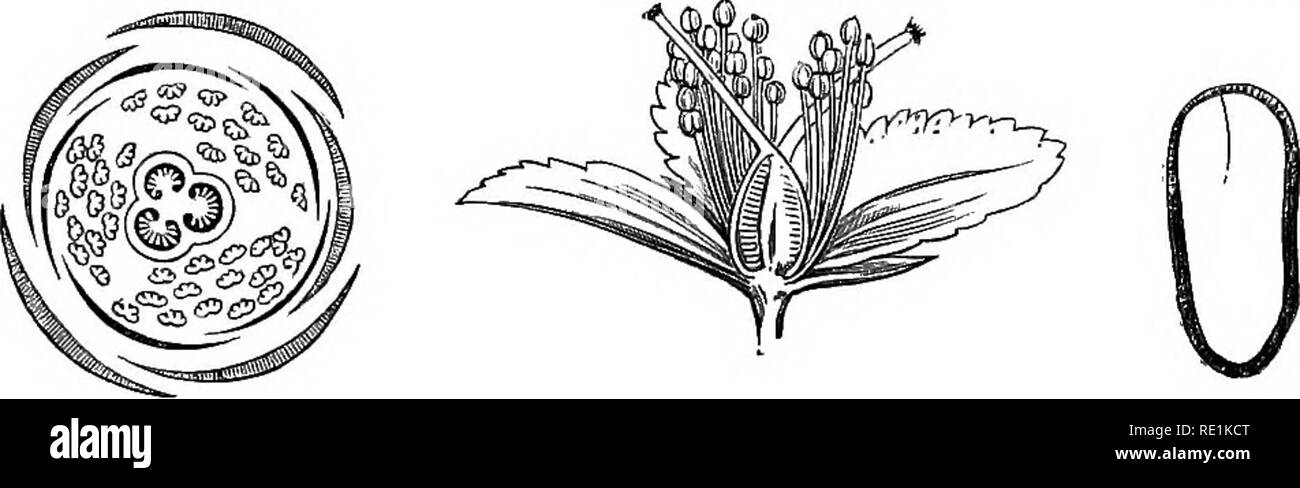. A manual of botany. Botany. DICOTYLEDONES—THALAMIPLOR^ 291 rarely alternate, exstipulate, simple, entire, often dotted; some- times bordered with black glands. Flowers regular. Sepals 4 or 5, persistent, imequal, distinct or united at the base, imbricate. Petals equal in number to the sepals, hypogynous, unequal- sided, frequently bordered with black glands ; cestivation twisted. Stamens usually numerous, rarely few, hypogynous, polyadel- phous, or rarely distinct, or monadelphous, sometimes having glands alternating with the bundles of stamens; filaments filiform; anthers 2-celled, with lon

Image details
Contributor:
The Book Worm / Alamy Stock PhotoImage ID:
RE1KCTFile size:
7.1 MB (245.8 KB Compressed download)Releases:
Model - no | Property - noDo I need a release?Dimensions:
2854 x 875 px | 24.2 x 7.4 cm | 9.5 x 2.9 inches | 300dpiMore information:
This image is a public domain image, which means either that copyright has expired in the image or the copyright holder has waived their copyright. Alamy charges you a fee for access to the high resolution copy of the image.
This image could have imperfections as it’s either historical or reportage.
. A manual of botany. Botany. DICOTYLEDONES—THALAMIPLOR^ 291 rarely alternate, exstipulate, simple, entire, often dotted; some- times bordered with black glands. Flowers regular. Sepals 4 or 5, persistent, imequal, distinct or united at the base, imbricate. Petals equal in number to the sepals, hypogynous, unequal- sided, frequently bordered with black glands ; cestivation twisted. Stamens usually numerous, rarely few, hypogynous, polyadel- phous, or rarely distinct, or monadelphous, sometimes having glands alternating with the bundles of stamens; filaments filiform; anthers 2-celled, with longitudinal dehiscence. Oviry 1-celled, formed of from 3 to 5 carpels, which are partially inflected so as to project into the cavity; or 3—5-celled by the union of the dissepiments in the centre; styles equal in number to the carpels; stigmas usually capitate or truncate, rarely 2-lobed. Fruit capsular, usually 3—ii-oelled, sometimes Fig. 1062. Fig. 1063.- Fig. 1064.. Fig. 1062. Diagram of tlie flower of a species of St. Johu's Wort (Hyperi- cum). Fig, 1063. Vertical section of tlae flower of the same. Fig. 1064. Yertical section of tlie seed. 1-celled; placentas axile or parietal, dehiscence septicidal. Seeds minute, numerous, exalbuminous; embryo straight or curved. Diagnosis.—Leaves entire, often dotted, exstipulate. Flowers regular. Sepals and petals hypogynous, with a quaternary or quinary distribution ; the former with an imbricate aestivation ; the latter unequal-sided, commonly marked with black glands, and having a twisted aestivation. Stamens hypogynous, usually numerous and polyadelphous, rarely few, and then distinct or monadelphous; anthers 2-celled, opening longitudinally. Styles several. Eruit l-celled, or 3—5-ceUed. Seeds numerous, ex- albuminous. Distrihution and Numbers.—The plants are generally dis- tributed over the globe, inhabiting both temperate and hot regions, and almost all varieties of soil. Illustrative Genera :— Hypericum, Linn.: Vismia